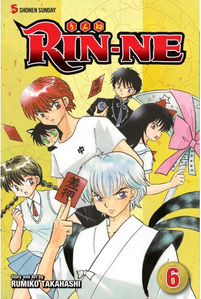Review
by Rebecca Silverman,RIN-NE
GN 6
| Synopsis: |  |
||
Rinne Rokudo, perpetually impoverished shinigami, may finally be in over his head. His ne'er-do-well father fleeced an attractive widow out of her savings, and now the widow's son is after Rinne to pay his father's debts! If he doesn't have the money, that's fine – Kain will simply take something else that Rinne cannot live without. In the meantime at school, Rinne and Sakura deal with a delinquent ghost who doesn't know she's dead and Tsubasa discovers just how much he dislikes his rival in love. |
|||
| Review: | |||
Like most of Rumiko Takahashi's series, there's a lot going on in this one volume. Rin-ne has consistently been episodic in nature, and that holds true here as well. This book contains three stories of varying lengths and comedy, and while it doesn't achieve greatness, it does manage to be enjoyable. The volume kicks off where the previous left off – with the Power Stone that Tsubasa retrieved from the haunted cedar. The stone appears to be tainted with negative energy, rendering it unusable. Unfortunately for Tsubasa, Masato the devil makes a return appearance and further contaminates things. This three chapter arc is pure slapstick, and if you enjoy that type of humor, it's pretty fun, although Takahashi's trademark “fallen hands” (middle and ring fingers folded with pinky, pointer, and thumb extended) do look dated. Perhaps that dated quality is the greatest deterrent to newer fans. Takahashi has built her career on silly, troubled romance-comedies, and while the plot may vary from aliens to martial arts to time travel, her take on the supernatural high school story is still clearly part of her cannon. For people who have been here since Urusei Yatsura, that's not a problem. But younger readers may find themselves annoyed by the slower pace and episodic format, both of which are a bit passe in contemporary English-translated shonen. Her art also has a retro look, but this is less likely to matter, largely because she does it well. Bodies are pleasantly formed, faces have enough expression to make it clear what's going on in the characters' heads, and supernatural characters look just nonhuman enough to make them otherworldly. Some of Takahashi's small details are excellent, like Kain wearing sneakers with his shinigami robes or the slices of almond on a cookie. Little things like this give the reader a sense of the effort Takahashi put into her otherwise simple artwork. The longest arc in this book is the one about Kain, although it appears to wrap up at the volume's end. (Or rather, it finishes enough that the main action is clearly over.) Although it is the lengthiest, it is not the strongest. Rinne's father Sabato's tendency to spend more than he can pay back is by this point an irritating gag used to force our hero into some unpleasant situation. Kain's attempts at getting his revenge almost redeem things, though – his methods are unusual enough to rid the chapters of the taint of the reused jest. The arc also gives Sakura more to do than just follow Rinne around. At times in the series her role has been reduced to the braids of the operation, but this section gives her a chance to prove to readers just why she's the heroine. Characterization-wise, there is not much development going on. Sakura does get to strut her stuff a bit, and Rinne seems like he might just be starting to get a clue about any feelings he may have for her, but otherwise, the characters are at a comfortable standstill. Rinne is poor and a bit clueless, Sakura is wisely with it, and Tsubasa tries real hard but doesn't quite make the grade. Rokumon continues to play the faithful sidekick, but the cat lovers out there will just be content to look at him – Takahashi does a bang up job of making his small form cute. Viz's translation is a bit lacking this time – in cultural notes, that is. Where previous volumes have had a section of notations about specific items or words, this one does not, giving it a bit of an air of otaku privilege. Yes, by this point we all know what the basic honorifics mean, but why does the delinquent spray paint “yoroshiku” on the wall? Why do the shinigami clerks wield staves with mirrors on them? And is it really safe to assume that all manga readers know what taiyaki is? These are the most egregious examples of no notes, and if such glosses hadn't been included in previous books in the series, there would be no, or at least less, cause for complaint. But given the precedent set in Rin-ne, it is an issue worth noting, as it turns the book into a bit of a Japanese culture quiz. When all is said and done, if you aren't tired of Takahashi yet, this is good read. It's even a good read if you are tired of her style or if you know nothing about her, but it isn't a great one. Rin-ne is a fun take on the supernatural school story, and if it isn't innovative or a work of staggering genius, it does show us why Rumiko Takahashi still sells – the woman can keep you reading. |
|
The views and opinions expressed in this article are solely those of the author(s) and do not necessarily represent the views of Anime News Network, its employees, owners, or sponsors.
|
| Grade: | |||
Overall : B-
Story : C
Art : B
+ Pleasant art, nice details, Sakura gets a chance to show she's not just a pretty face. |
|||
| discuss this in the forum (3 posts) | | |||
| Production Info: | ||
|
Full encyclopedia details about Release information about |
||